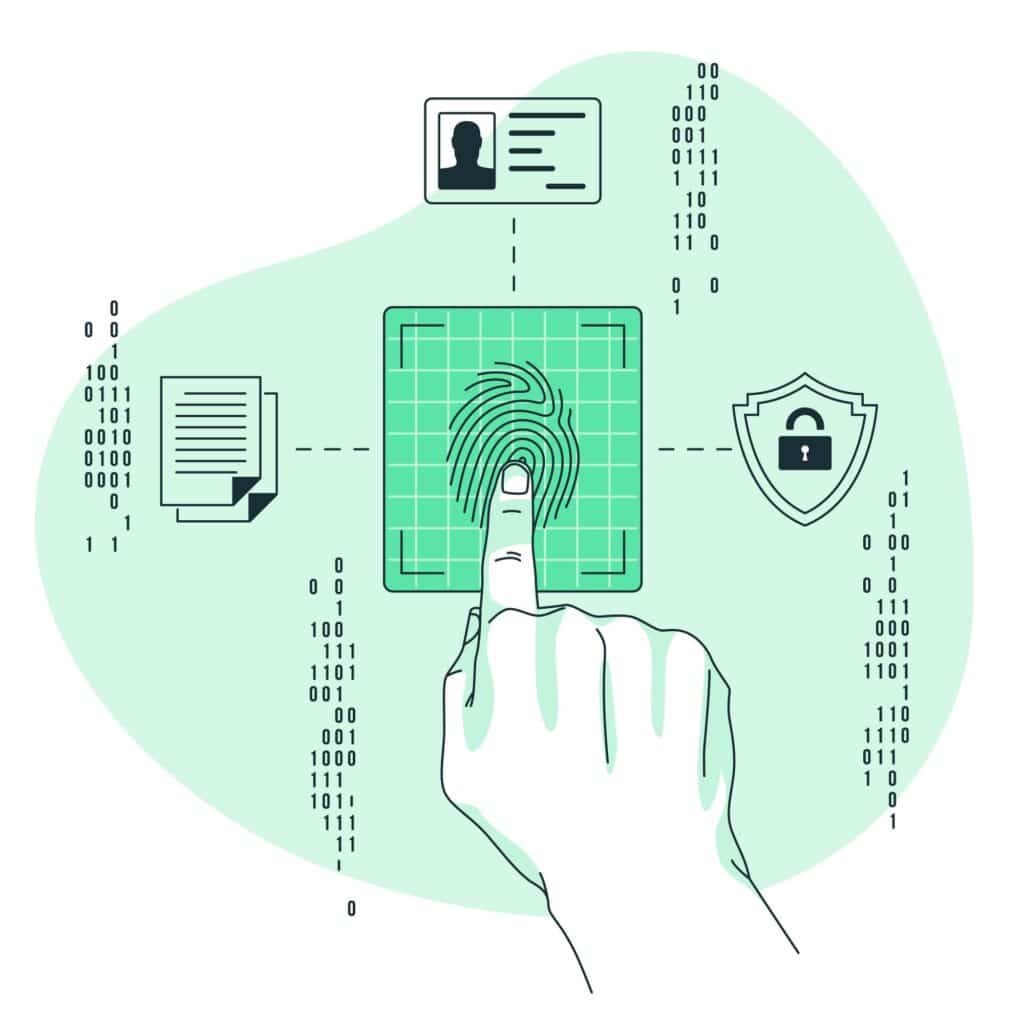Advancing Security The Evolution Of Electronic Identity Verification Eidv

In today’s rapidly evolving digital landscape, the importance of secure and effective methods for identity verification cannot be overstated. Traditional approaches are proving inadequate in combating the increasingly sophisticated tactics employed by fraudsters. Consequently, Electronic Identity Verification (EIDV) has emerged as a solution, marking a transition from paper-based to digital verification processes that incorporate biometric authentication and artificial intelligence.
While EIDV offers businesses enhanced security, improved customer experiences, and cost savings, it also presents challenges such as privacy considerations and accessibility issues. Looking forward, the future of EIDV entails its integration with blockchain technology, expansion into new sectors, and ongoing advancements in biometric technology.
An exploration of the significance, advantages, obstacles, and trajectory of EIDV is vital within the context of today’s digital environment.
What Is Electronic Identity Verification (EIDV)?
Electronic Identity Verification (EIDV) is a process that electronically confirms an individual’s identity through various means, including biometric data, personal information, and document validation.
In the realm of contemporary security measures, EIDV plays a vital role in mitigating identity theft, fraud, and unauthorized access to sensitive information. This verification process ensures the authenticity of individuals providing their identity details, thereby bolstering security in digital transactions and online interactions.
The methods utilized for electronic identity verification encompass knowledge-based authentication, biometric recognition, behavioral authentication, and two-factor authentication. These methods leverage advanced technologies to accurately verify identities, positioning EIDV as an essential element within the current digital security landscape.
The Importance of EIDV in Today’s Digital World
In the contemporary digital landscape, Electronic Identity Verification (EIDV) plays a pivotal role in guaranteeing secure transactions, verifying users, and shielding digital identities from fraudulent activities and cyber vulnerabilities.
The implementation of EIDV enables organizations to mitigate the risks related to identity theft and unauthorized account access, consequently safeguarding the interests of both consumers and enterprises. This verification procedure facilitates the online authentication of individuals, ensuring the appropriate individual is engaging with digital services and platforms. EIDV bolsters security frameworks by validating users through diverse methodologies such as biometric information, knowledge-based authentication, and document scrutiny. This multifaceted approach not only reinforces security protocols but also fosters confidence and credibility within the digital domain.
Why Traditional Identity Verification Methods Are No Longer Enough
The advancement of technology has led to the inadequacy of conventional identity verification methods in managing the complexities of contemporary identity verification. Relying on physical identity documents and manual verification procedures is no longer deemed efficient or secure.
The escalation of intricate fraud methods and the growing incidence of identity theft have heightened the vulnerability of manual verification processes to errors and fraudulent activities.
Furthermore, the labor-intensive characteristics of manual verification may result in customer onboarding delays and impede the overall user experience.
As enterprises aim to fortify security protocols and optimize operational procedures, there is an imperative demand for sophisticated electronic identity verification solutions.
The Evolution of EIDV
The advancement of Electronic Identity Verification (EIDV) has undergone a notable transformation from manual procedures to automated protocols and sophisticated technologies aimed at enhancing the precision and efficiency of identity verification.
This shift from conventional manual approaches to automated verification systems has brought about a revolution in the methods by which businesses and organizations validate the identities of their clientele. The incorporation of cutting-edge technologies like biometrics, artificial intelligence, and machine learning has played a critical role in streamlining the verification process and ensuring an elevated standard of security. These innovative tools have facilitated the seamless integration of identity verification procedures into online platforms, providing a more convenient and user-friendly experience for both enterprises and customers.
The Shift from Paper-Based to Digital Verification
The transition from traditional paper-based identity verification methods to digital solutions has brought about a significant transformation in the realm of identity authentication. This shift has resulted in the development of robust and efficient identity verification systems that conform to rigorous standards.
These digital systems have notably enhanced the accuracy and dependability of the identity verification process, providing a seamless and expeditious procedure that minimizes inaccuracies and enriches the overall user journey.
Through the digitalization of verification procedures, organizations can not only optimize their operations but also mitigate the risk of fraudulent activities, ensuring that only authorized individuals are granted access to sensitive information or services.
Adherence to identity verification standards is paramount in the contemporary digital landscape to fortify defenses against identity theft and uphold the confidence and trust of customers and users.
The Emergence of Biometric Authentication
Biometric authentication has emerged as an innovative technology within Electronic Identity Verification (EIDV), providing robust access control and precise identity validation through unique biological characteristics.
This sophisticated approach strengthens security protocols by accurately confirming individuals based on their distinctive traits, such as fingerprints, facial features, iris patterns, or voice recognition. By harnessing these inherent attributes, biometric authentication mitigates the risk of identity theft and unauthorized entry, establishing itself as a critical element across various sectors like finance, government services, and healthcare. The efficacy of this method stems from the inherent difficulty of replicating or falsifying these biological markers, ensuring a heightened level of security and confidence in digital identity verification procedures.
The Role of Artificial Intelligence in EIDV
Artificial Intelligence (AI) significantly enhances Electronic Identity Verification (EIDV) by enabling proactive fraud prevention measures, optimizing identity management processes, and improving the overall efficiency of verification workflows.
AI accomplishes this through the utilization of sophisticated algorithms for rapid and precise analysis of extensive datasets. It effectively identifies patterns and anomalies that human oversight might overlook. By automating the verification process, AI substantially mitigates the risks associated with fraudulent activities, thereby safeguarding sensitive information and fostering trust between businesses and customers. AI-driven identity management systems provide real-time updates and adaptive functionalities, ensuring that verification procedures remain current and compliant with ever-evolving regulatory standards.
Benefits of EIDV
The process of Electronic Identity Verification (EIDV) offers numerous advantages, such as heightened security measures, proactive fraud prevention, and robust data protection mechanisms to safeguard sensitive information.
By utilizing sophisticated technology, EIDV processes efficiently verify and authenticate individuals’ identities, consequently lowering the risk of unauthorized access and identity theft. This seamless procedure not only enriches the user experience but also optimizes operations for businesses operating across diverse sectors.
EIDV plays a pivotal role in regulatory compliance by ensuring that only verified individuals gain access to sensitive data, thereby upholding transparency and trust in financial transactions. Through EIDV, organizations can securely authenticate users remotely, facilitating a digital transformation that prioritizes security and privacy.
Increased Security and Fraud Prevention
One of the primary advantages of Electronic Identity Verification (EIDV) lies in its ability to enhance security, facilitating secure transactions, proactive fraud deterrence, and robust cybersecurity measures.
The utilization of EIDV serves not only to confirm the identities of individuals involved in online transactions but also plays a critical role in thwarting fraudulent behaviors. By verifying user identities, EIDV reinforces security protocols, shields against identity theft, and diminishes the likelihood of unauthorized access. The introduction of EIDV substantially diminishes the occurrence of data breaches and cyber threats, thereby establishing a secure digital sphere for both enterprises and customers. The proactive stance of EIDV in identifying fraudulent activities early enables organizations to detect suspicious behaviors promptly, allowing them to implement necessary precautions and uphold the integrity of their systems.
Improved Customer Experience
The utilization of Electronic Identity Verification (EIDV) serves to augment the customer experience by optimizing user authentication procedures, simplifying identity management, and furnishing secure access to digital services.
This sophisticated technology give the power tos businesses to expedite and streamline the verification of customer identities, thereby diminishing the necessity for manual verification processes and mitigating the potential risk of fraudulent activities. Through the automation of authentication procedures, EIDV guarantees a seamless user experience, consequently elevating customer satisfaction levels.
The integration of simplified identity management tools enables users to effortlessly update and maintain their personal information, thereby enhancing overall convenience. The provision of secure access facilitated by EIDV ensures that customers can securely access digital services without compromising the integrity of their personal data, thereby fostering trust and engendering loyalty.
Cost Savings for Businesses
The incorporation of Electronic Identity Verification (EIDV) solutions can lead to substantial cost savings for businesses through the optimization of identity verification processes, guaranteeing adherence to regulatory standards, and diminishing operational expenses.
These solutions present a seamless method for authenticating customer identities, allowing organizations to swiftly and accurately confirm individuals’ identities. This efficacy not only enhances security protocols but also mitigates the likelihood of fraudulent activities.
By automatizing the verification procedure, businesses can efficiently manage increased transaction volumes, thereby enhancing overall productivity. The decrease in manual errors and the eradication of paper-based documentation contribute to streamlined operations and enhanced customer experiences, ultimately decreasing costs linked to verification and compliance protocols.
Challenges and Limitations of EIDV
Despite its advantages, Electronic Identity Verification (EIDV) encounters challenges and constraints such as identity verification risks, adherence to stringent regulations, and the necessity to address evolving security vulnerabilities.
The implementation of EIDV solutions can present complexities due to the dynamic nature of security risks and the obligations imposed by diverse regulatory frameworks. Organizations frequently encounter difficulties in harmonizing the demand for robust identity verification procedures with the imperative of delivering a seamless user experience. The dependence on digital identities introduces susceptibilities that malicious actors may exploit, potentially resulting in data breaches and fraudulent activities.
To mitigate these risks, enterprises must allocate resources towards advanced authentication techniques, regular security evaluations, and employee training programs to elevate their overall data protection protocols.
Privacy Concerns
Privacy concerns present a significant challenge in Electronic Identity Verification (EIDV) due to the collection and storage of sensitive data, which give rise to issues related to data protection, identity theft, and unauthorized access.
These concerns are rooted in the potential vulnerabilities that can emerge from the substantial amount of personal information involved in the verification process. Cybercriminals consistently target such data, posing a considerable risk of identity theft to individuals. The threat of unauthorized access to this data is considerable, especially given the increasing sophistication of hacking methods. Organizations that deploy EIDV must prioritize robust security measures to protect sensitive information and address the potential repercussions of breaches or misuse.
Accessibility and Inclusivity
Ensuring accessibility and inclusivity in Electronic Identity Verification (EIDV) practices is paramount to effectively tackle the challenges associated with the availability of verification tools, the usability of verification methods, and the necessity for equitable identity verification protocols.
Prioritizing accessibility enables organizations to facilitate a seamless navigation of the identity verification process for individuals hailing from diverse backgrounds. Inclusivity is essential in the development of verification tools that accommodate a spectrum of requirements, including multi-language support and alternative verification methodologies tailored for individuals with disabilities. The usability of these tools should be user-centric to optimize the verification process’s efficiency and improve overall user experience. Embracing equitable identity verification practices not only upholds fairness but also guards against discrimination, fostering trust and compliance among a broad spectrum of user demographics.
Future of EIDV
The forthcoming trajectory of Electronic Identity Verification (EIDV) is characterized by the potential for continued advancements, the resolution of current obstacles, and the incorporation of novel technologies to augment the dependability and security of identity verification procedures.
Anticipated progressions in artificial intelligence and biometric technologies are poised to play a pivotal role in the transformation of EIDV methodologies. Through the utilization of machine learning algorithms to bolster fraud detection capabilities and the integration of biometric authentication mechanisms such as facial recognition or fingerprint scanning, the sector strives to reinforce its authentication protocols. The adoption of blockchain technology is expected to bring about a paradigm shift in data security and confidentiality within identity verification frameworks, thereby ensuring a more resilient and transparent verification process for individuals and enterprises alike.
Integration with Blockchain Technology
The amalgamation of Electronic Identity Verification (EIDV) with blockchain technology stands at the forefront of transforming identity verification practices, offering unmatched security, transparency, and adherence to regulatory frameworks.
Through the utilization of blockchain’s decentralized and immutable characteristics, EIDV can establish a tamper-proof system that secures confidential identity data against unauthorized manipulation or access. This convergence of technologies not only boosts the effectiveness and precision of identity verification procedures but also give the power tos individuals to exert greater control over their personal information. The integration of EIDV with blockchain technology streamlines cross-border transactions, reducing the vulnerabilities associated with identity theft and fraudulent activities.
Expansion into New Industries
The integration of Electronic Identity Verification (EIDV) into emerging sectors highlights the expanding market for identity verification services, demonstrating its varied applications across industries such as finance, healthcare, and e-commerce.
Industries outside the conventional realms are increasingly acknowledging the advantages and security enhancements associated with the adoption of EIDV solutions in their operations. Entities within areas like travel, education, and real estate are utilizing EIDV technologies to optimize workflows, bolster customer confidence, and mitigate risks related to fraudulent activities.
The adaptability of EIDV equips enterprises to adhere to regulatory mandates while delivering a seamless user interface. With this progression gaining traction, EIDV service providers are advancing their offerings to address the distinct requirements of various sectors, thereby propelling further market growth.
Continued Advancements in Biometric Technology
The continuous progress in biometric technology is transforming Electronic Identity Verification (EIDV), introducing novel protocols and technologies that enhance the accuracy, security, and user experience of identity verification.
These state-of-the-art advancements in biometrics encompass facial recognition, iris scanning, voice recognition, and fingerprint scanning, all of which contribute to improving the precision of authentication while reducing instances of fraudulent activities. By incorporating various biometric modalities, tailored solutions have been developed to offer multifactor authentication, thereby adding additional layers of security to EIDV procedures. These advancements also optimize the identification processes, rendering them more expedient and effective, thereby improving the overall customer experience and mitigating the risks associated with identity theft and cybercrimes.
Frequently Asked Questions
What is Electronic Identity Verification (EIDV)?
Electronic Identity Verification (EIDV) is a process used to verify the identity of an individual using electronic means, such as online databases, biometric data, and government-issued IDs. This helps to ensure the authenticity and accuracy of an individual’s identity, especially in the digital world.
How has EIDV evolved over time?
EIDV has evolved significantly over time due to advancements in technology and the increasing need for secure identification in various industries, such as banking, healthcare, and government. From simple username and password combinations to more sophisticated biometric technologies, EIDV has become more accurate and efficient.
What are the benefits of EIDV?
There are many benefits to using EIDV, including improved fraud prevention, faster and more accurate identity verification, and enhanced customer experience. EIDV also helps to mitigate the risks associated with human error and manual verification processes.
Is EIDV secure?
Yes, EIDV is a highly secure process that utilizes various security measures like encryption, multi-factor authentication, and real-time data verification to ensure the accuracy and authenticity of an individual’s identity. However, it is important to choose a reputable and trusted EIDV provider to ensure the highest level of security.
What industries can benefit from EIDV?
EIDV can benefit a wide range of industries, including financial services, healthcare, government, education, and retail. Any industry that requires secure identification and verification of individuals can benefit from implementing EIDV solutions.
How can I implement EIDV in my business?
To implement EIDV in your business, you can partner with a trusted and reliable EIDV provider. They will work with you to understand your specific needs and provide a customized solution that fits your business requirements. It is important to choose a provider that offers advanced security features and compliance with industry regulations.



